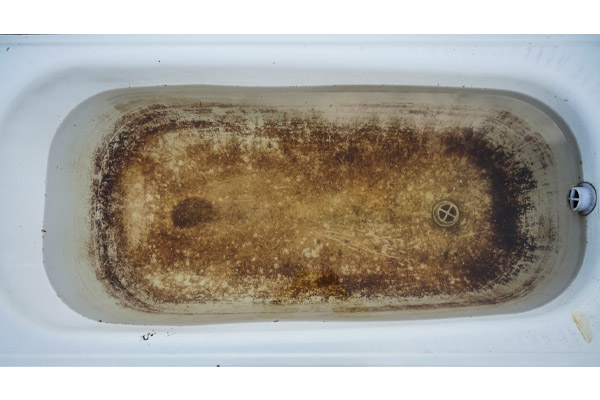Understanding Why Sewage Comes Up Through the Bathtub
Understanding Why Sewage Comes Up Through the Bathtub
Blog Article
Almost everyone may have their personal perception when it comes to What To Do If Sewage Starts Backing Up Into the Shower.

Sewer backup in the tub can be an upsetting and unhygienic issue for any type of property owner. Not only is it bothersome, but it additionally poses major health dangers and suggests underlying problems with the plumbing system. Recognizing why sewage is turning up with the bath tub is crucial for taking ideal action to address the problem properly.
Intro to the Concern
Recognizing the Issue
When sewage draws back up right into the tub, it's a clear indicator of an issue with the drain system. The wastewater that ought to be moving far from your home is rather discovering its way back into your home, which can lead to considerable damages and carcinogen.
Prospective Causes
A number of aspects can contribute to sewer backup in the tub. From blockages in the sewage system line to problems with the plumbing infrastructure, identifying the origin is necessary for discovering a solution.
Common Factors for Sewage Backup
Clogs in the Sewage System Line
One of one of the most common root causes of sewer back-up is an obstruction in the sewage system line. This can take place due to the build-up of particles, oil, or international objects in the pipes, protecting against proper flow and triggering sewer to support into your bathtub.
Tree Root Breach
Tree origins looking for wetness and nutrients can penetrate sewer lines with small splits or joints. Over time, these roots can grow and broaden, causing significant damage to the pipes and causing sewer backup problems.
Aging Facilities
Older homes might have obsoleted plumbing systems that are more prone to deterioration, splits, and deterioration. As pipes age, they end up being a lot more vulnerable to leakages and obstructions, enhancing the chance of sewer backup events.
Heavy Rainfall or Flooding
During durations of heavy rainfall or flooding, the drain system may come to be overloaded with excess water, triggering backups and overflows. This can result in sewage backing up right into tubs and other components inside the home.
Health And Wellness Risks Associated with Sewer Back-up
Contamination of Water System
Sewage back-up can pollute the water in your house, positioning a serious wellness threat to you and your household. Exposure to polluted water can cause intestinal problems, skin infections, and various other ailments.
Spread of Disease
Sewer consists of harmful germs, infections, and parasites that can trigger a series of illness, consisting of liver disease, cholera, and gastroenteritis. Entering into contact with sewage or contaminated surfaces places you in jeopardy of infection.
Mold and mildew Development
Dampness from sewer backup can produce suitable problems for mold growth in your house. Mold and mildew spores can aggravate respiratory system issues and trigger allergic reactions in delicate people, making timely clean-up vital.
Indications of Sewage Backup
Foul Odors
Unpleasant smells originating from drains or fixtures, particularly in the bathroom, might indicate sewer backup concerns. These smells are typically strong and persistent, signifying an issue that requires prompt focus.
Slow Draining Fixtures
Bathtubs, sinks, and commodes that drain pipes gradually or otherwise in any way could be experiencing sewage back-up. If multiple components are affected at the same time, it's most likely that the issue stems from a common point, such as the major drain line.
Gurgling Sounds
Strange gurgling or gurgling noises originating from drains when water is running somewhere else in the house are a measure of air trapped in the plumbing system. This air build-up can arise from sewer backup and must be investigated promptly.
Immediate Actions to Take
Shutting Off Water
In the event of sewage back-up, it's necessary to shut off the water to prevent more contamination and damages. Situate the main water shutoff valve in your home and closed it off till the issue can be fixed.
Speaking To a Professional Plumber
Managing sewer back-up is not a do it yourself work. Contact a certified plumber with experience in managing sewage-related problems to examine the situation and perform required repair work or cleanups.
Avoiding Contact with Polluted Water
Up until the sewage back-up is resolved, avoid contact with polluted water to avoid the spread of bacteria and pathogens. Put on safety gear if you have to remain in the afflicted area and clean your hands extensively later.
Safety nets
Routine Maintenance of Sewage System Lines
Schedule normal assessments and maintenance of your sewer lines to identify and resolve prospective concerns before they escalate right into major problems. This can consist of cleaning out particles, examining for tree origin invasion, and fixing any kind of damaged pipelines.
Setting Up Backwater Shutoffs
Consider mounting backwater shutoffs in your plumbing system to avoid sewer from flowing back into your home throughout periods of heavy rainfall or flooding. These shutoffs automatically close when water draws back up, securing your building from contamination.
Proper Disposal of Family Waste
Stay clear of flushing anything other than bathroom tissue and human waste down the commode to prevent blockages and clogs in the sewage system line. Dispose of oil, oil, and other home chemicals appropriately to lessen the danger of plumbing problems.
Tidying up After Sewage Backup
Disinfection Procedures
Completely decontaminate and disinfect impacted locations after sewage backup to eliminate unsafe bacteria and stop mold and mildew development. Usage ideal cleaning products and protective equipment to ensure safe and reliable cleaning.
Remediation of Influenced Areas
Fix any kind of damages to floor covering, wall surfaces, or fixtures caused by sewage back-up. Relying on the extent of the damage, you might require to change carpeting, drywall, or other materials to recover your home to its pre-loss problem.
Sewage Coming Up Through the Bathtub?
Understanding the Plumbing System:
To understand why sewage is coming up through your bathtub, it is essential to have a basic understanding of the plumbing system. The plumbing system is a complex network of pipes, valves, fixtures, and drains that work together to provide clean water to your home and remove waste and sewage. The system consists of two parts: the supply system and the drainage system.
The supply system brings clean water to your home, while the drainage system removes wastewater from your sinks, toilets, showers, and bathtubs. The drainage system is connected to the main sewer line, which carries the wastewater to the municipal sewage treatment plant or septic tank.
Causes of Sewage Coming Up Through the Bathtub:
Sewage coming up through the bathtub can be caused by various factors. Some of the most common causes are:
Clogged Drain Pipes:
One of the most common reasons for sewage coming up through the bathtub is a clogged drain pipe. Over time, debris, hair, soap scum, and other foreign objects can accumulate in the drain pipes, leading to a blockage. This can cause the wastewater to back up and come out of the bathtub.
Main Sewer Line Blockage:
Another reason for sewage coming up through the bathtub is a blockage in the main sewer line. The main sewer line connects your home’s drainage system to the municipal sewer system. If the main sewer line gets clogged due to tree roots, grease buildup, or other obstructions, it can cause sewage to back up into your home’s plumbing fixtures, including the bathtub.
Sewage Backup:
Sewage backup is another common cause of sewage coming up through the bathtub. Sewage backup occurs when there is a problem with the municipal sewer system, such as heavy rainfall, flooding, or a malfunctioning pump. When this happens, sewage can flow back into your home’s drainage system and cause sewage backup in your plumbing fixtures, including the bathtub.
Broken or Damaged Pipes:
Finally, broken or damaged pipes can also cause sewage to come up through the bathtub. Over time, pipes can deteriorate due to age, corrosion, or external factors such as shifting soil. When pipes break or crack, wastewater can leak out and cause sewage backup in your plumbing fixtures.
Signs of Sewage Coming Up Through the Bathtub:
Some of the signs that sewage is coming up through your bathtub include:
Foul odor: If you notice a strong, unpleasant odor coming from your bathtub drain, it could be a sign of sewage backup. The smell is caused by the buildup of organic waste in the pipes. Slow drainage: If your bathtub drains slowly or not at all, it could be a sign of a clogged drain pipe or a more severe problem with the main sewer line. Gurgling sounds: If you hear gurgling sounds coming from your bathtub drain or other plumbing fixtures, it could indicate that air is trapped in the pipes due to a blockage. Prevention Measures:
The best way to prevent sewage from coming up through the bathtub is to take preventative measures. Here are some practical tips:
Regular Drain Cleaning:
Regular drain cleaning can help prevent clogs and keep your pipes in good condition. You can use a plunger, drain snake, or enzymatic drain cleaner to remove any buildup of hair, soap scum, or other debris in your bathtub drain.
Proper Waste Disposal:
Improper waste disposal can also contribute to sewage backup. Avoid flushing non-biodegradable items, such as paper towels, feminine hygiene products, or wipes down the toilet. Also, be mindful of what you pour down the drain, such as grease, oil, or coffee grounds, as they can cause clogs.
Professional Plumbing Maintenance:
Regular plumbing maintenance can help prevent plumbing emergencies, such as sewage backup. A professional plumber can inspect your pipes, identify any potential issues, and perform preventative measures, such as hydro jetting, to clean your pipes.
Hydro Jetting:
Hydro jetting is a powerful method that uses high-pressure water to clean the pipes thoroughly. It can remove even the most stubborn clogs and prevent future blockages.

As a fervent reader on What To Do If Sewage Starts Backing Up Into the Shower, I thought sharing that excerpt was really useful. In case you enjoyed our blog entry kindly make sure you remember to share it. Thank you for being here. Return soon.
Call Today
Report this page